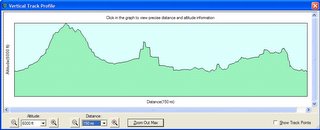ok I found the artice here
or you can do a google search for it and readmany good articles about pacing google search for the pace
The pace is a way of pushing yourself, learning about yourself and your bike. It helps analyze the roads ahead of you and ride at a speed that requires no hard quick breaking. In order to ride the pace you have to know your limits and your bikes limits and where ever they may diverge. In a lot of cases our bikes limits are actually more that the riders limits. It is the riders mind that makes him grab that break and straighten the bike up. It is the rider that is tentative to get off of his seat and lean with the bike. It is the rider that sees the gravel and panics and does something dumb. But in all fairness it is the rider that FEELS the pain if something goes wrong.
The way I think of the pace when I am out riding though may be a bit different that those in racing may think of it. It is a critical thinking that surrounds your riding. Analyzing the road ahead. Looking at the curve ahead and figuring out all of the logistics that come into it before ever approaching it. One of the first things I look for is the radius of the turn. Many times this can't be determined immediately so that is your first clue as to what you are getting into.
The second thing I look for is the bank or camber of the turn. The way I look at this is by looking for the yellow line. This may sound kind of wierd, or obscure but I will try to explain it easilly. If the yellow line is above the white the entire way through the curve then the camber is good for taking at a higher speed. If the lines converge, visually, at some point this is the place where the bank ends and you shold be decellerating a bit by this point. In the worst case the yellow line is not visible. This can mean a lot of bouncing, a rough turn, or a just a rough turn to take fast.
The third thing I look for is debris. The are many factors you can learn to detect where debris may be.
- First and foremost can you see and gravel, fine gravel, big rocks, hanging out waiting for you to slide through
- What have the conditions of the previous curve been.
- What is the side of the road like. If the side of the road contains a lot of gravel I have found it like that cars will take right hand turns sharp and through that gravel from the side right into your path.
With all of these things in mind the real "game" begins. The purpose of the pace is to get you to think critically, and ride hard. With all of these factors in mind adjust your speed BEFORE entering the turn. It is preffered that you dp this without the use of your break. You can coast, accelerate into it, or downshift if needed. Try not to hit your breaks all day. ( minus stop signs, traffic lights, and idiots around you). Start your day slowly. Learning the lean of your bike and the amount of lean you feel comfortable with. Dont freak yourself out early on. But generally speaking you can make most any curve you properly analyzed no matter how impossible it may feel.

